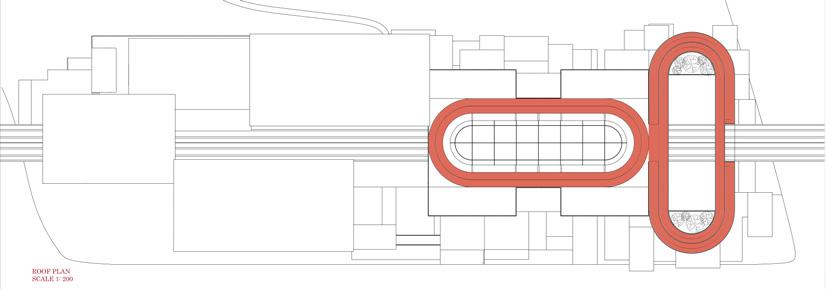0402745392
khoo.keat@hotmail.com

0402745392
khoo.keat@hotmail.com
Master of Architecture with a passion for design and 2 years of experience in architectural firms. Strongly equipped with a natural flair for the construction industry, supported by a family background in construction.
2023 - Current
Graduate of Architecture at McCabe Architects Projects:
i. Childcare Centre & Retail in Craigieburn, VIC
iii. Aveo Redmond Park, VIC
iv. Tocumwal Senior Housing Development, NSW
v. Community Centre & Sales Experience Centre in Waurn Ponds, VIC
vi. Schoolhouse Village Development, Maryborough, VIC
vii. Community Centre & Hangout Building in Aldinga, SA
viii. Heritage-Sensitive Residential Renovation & Extension in Portsea, VIC
vi. Schoolhouse Village Development, Maryborough, VIC
Responsibilities:
► Prepared site analysis diagrams for existing site conditions.
► Prepared a full set of drawings for town planning permit application.
► Preparing design response diagram and master plan overlays
► Prepared tender and construction-stage drawings
► Preparing 3D models and views for client presentations
► Developed a cohesive architectural approach for multiple buildings (clubhouse, sales experience centre, and hangout buildings) using consistent design elements and color palettes.
Design Review Panel at McCabe Architects
► Reviewed architectural drawings and provided RFIs based on design guidelines.
► Delivered assessment summaries to builders/architects, identifying non-compliance items.
Jan 2021 - Feb 2021
Student Architect at Mulloway Studio Projects:
i. Lameroo Shelter, SA
ii. Amadio Wines Bar, Kangaroo Island, SA
Jan 2018 - Mar 2018
Architectural Intern at Architect Ding Poi Kooi Projects:
i. Taman Bunga Tanjung
ii. HDA, Perak
► Taman Tugu Kuala Lumpur Greenovation Design Competition 2017 led by Khazanah National Berhad
► UEC gold virtues award holder
► Stractco Popup Venue 2020 hosted by School of Architecture and Built Environment
► 2020 University of Adelaide Global Citizen Scholarship holder
Michael Mccabe
(Available based on request)
mccabearchitects.com.au
Director of Mccabe Architects

Completion of Master of Architecture University of Adelaide 2020 Master of Architecture University of Adelaide 2017 Bachelor of Science (Honors) in Architecture Taylor’s University Lakeside Campus









Graduate of Architecture
Master of Architecture
2017-2021
Graduate of Architecture
2023-2025
Graduate of Architecture
Mccabe Architects
2023 - Current
Childcare & Retail Development
Town Planning Drawings & 3D Modelling
Craigieburn, VIC | 2024
Heritage Residential Extension
Concept Development
Portsea, VIC | 2024
Community Clubhouse
Town Planning Application & 3D Visualisation
Waurn Ponds, VIC | 2024
Estate Clubhouse & Communal Facilities
Town Planning Application & 3D Visualisation
Aldinga, SA | 2024
Estate Clubhouse & Communal Facilities
Town Planning Application & 3D Visualisation
Drouin, VIC | 2025
Mccabe Architects 2023- Current (2025)

What does it mean to step out of university and into the profession?
For me, joining McCabe Architects was where I began to understand how good ideas must meet real-world constraints. Budgets, setbacks, overlays, and open space rules became part of the design language—no longer theory, but active forces shaping the work.
From childcare centres to retirement housing and community clubhouses, I learned to document with clarity, communicate design intent professionally, and respond to planning conditions with buildable solutions.
This chapter wasn’t about abstract ideas—It was about learning how to create meaningful architecture within real limits.

Town Planning Drawings & 3D Modelling Mccabe Architects@2024
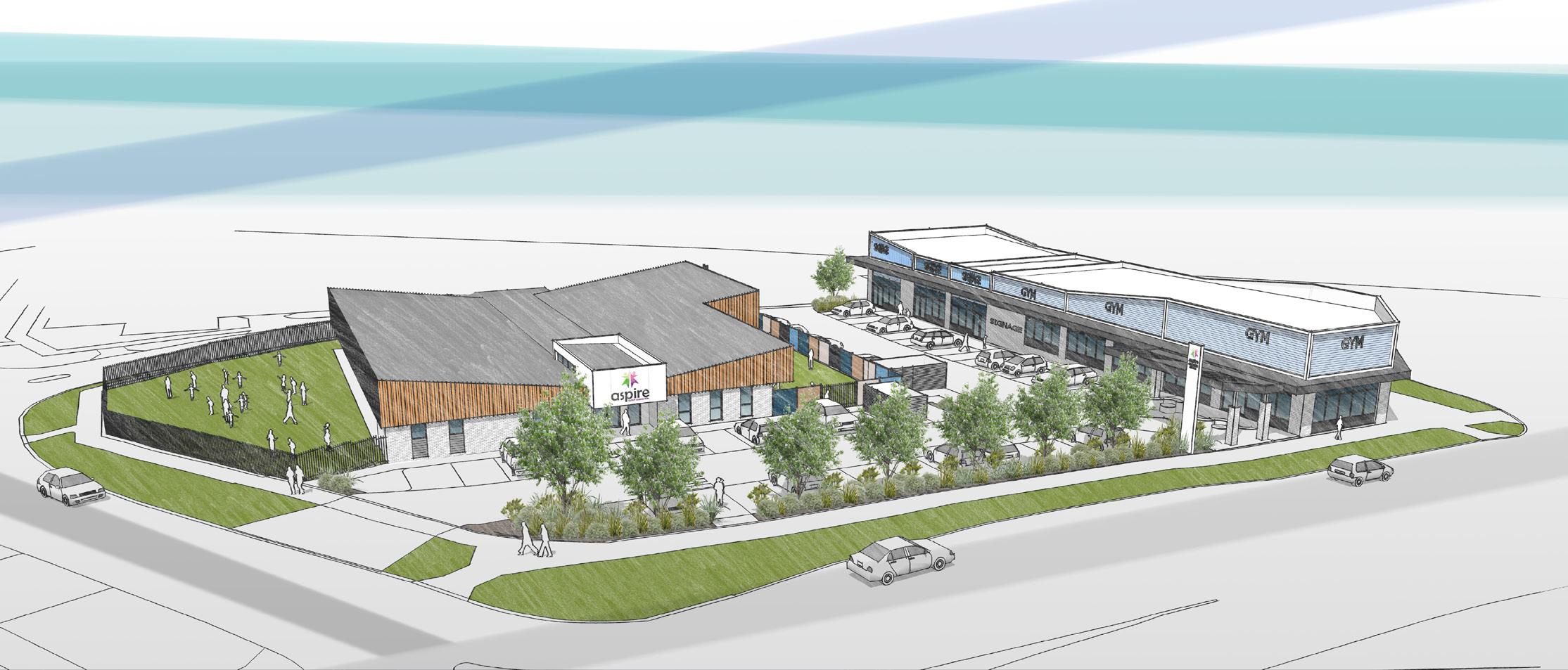
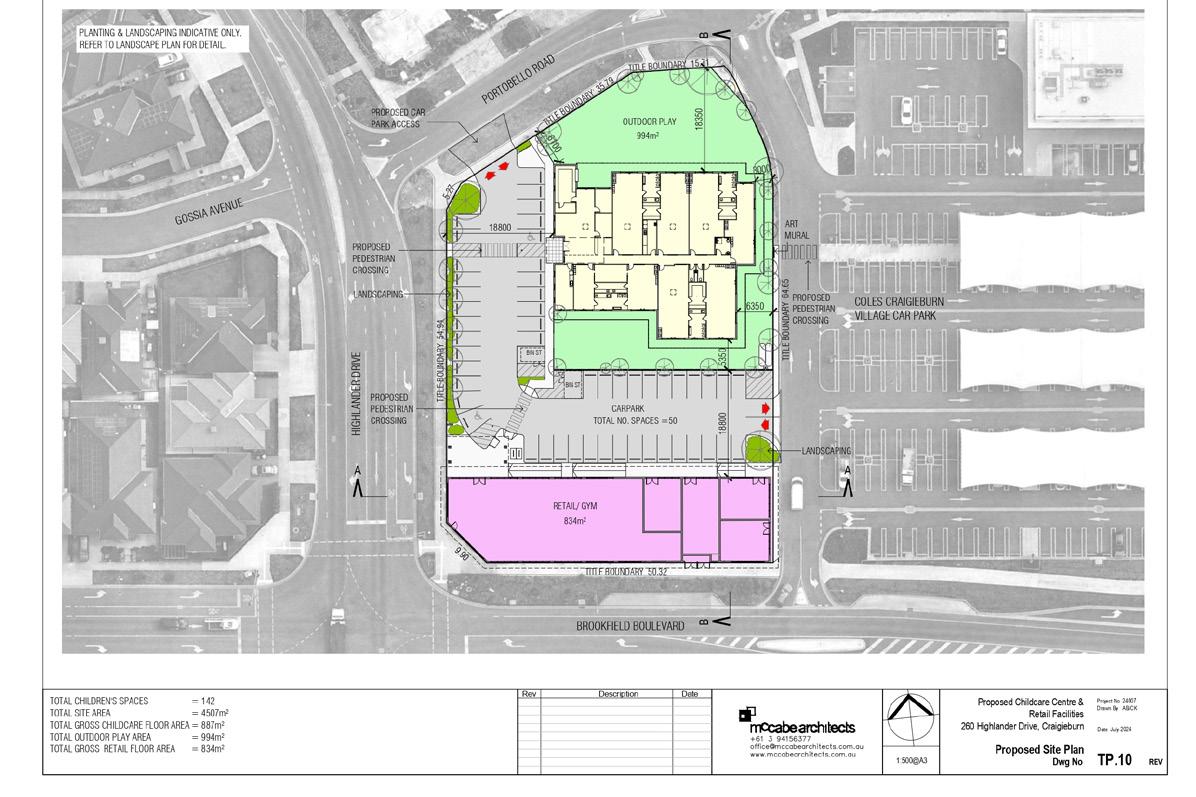
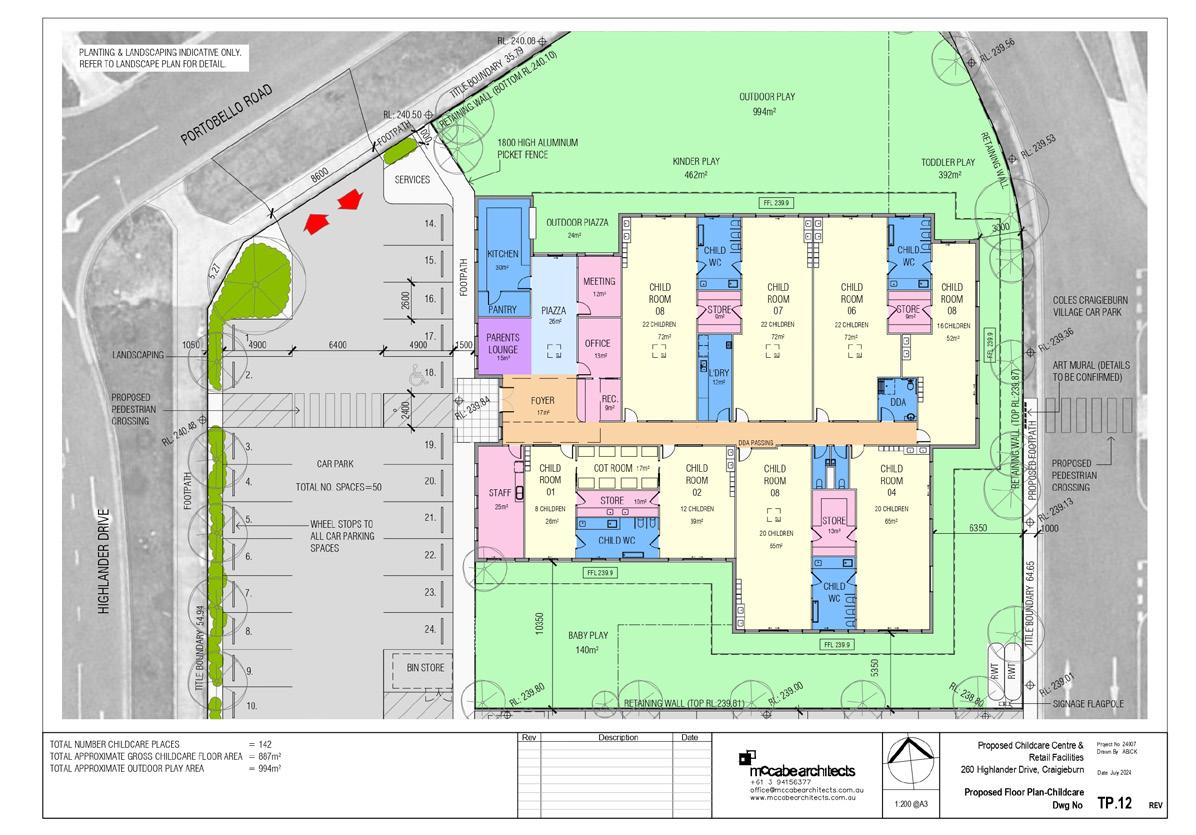
► Developed 3D models to effectively visualize design concepts.
► Prepared a complete set of town planning drawings for application submission.
► Provided design alternatives based on client requirements.
► Created a signage schedule and amended drawings in response to council RFIs.
Projects Challenges
► Balanced privacy for the childcare centre with retail visibility on a road-facing corner site.
► Proposed cost-effective design alternatives while maintaining architectural intent.
► Prepared a signage schedule to meet updated council expectations.
► Considered age-specific open space requirements in childcare planning.








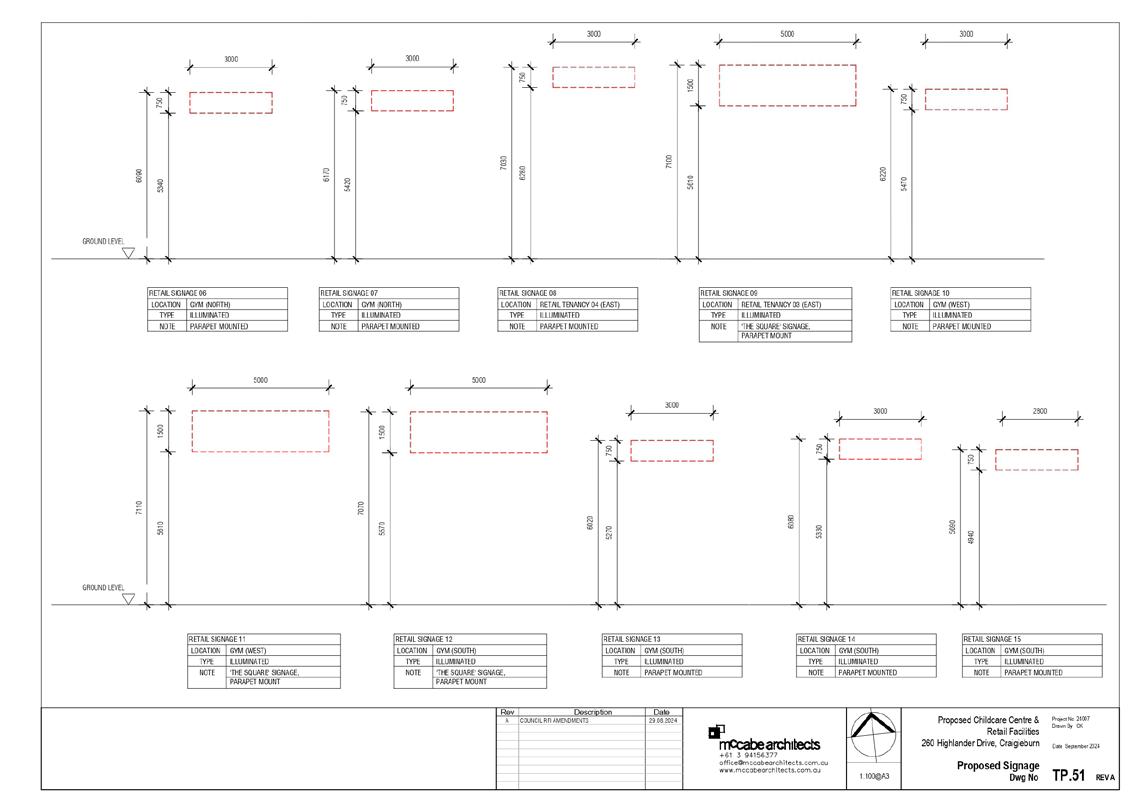
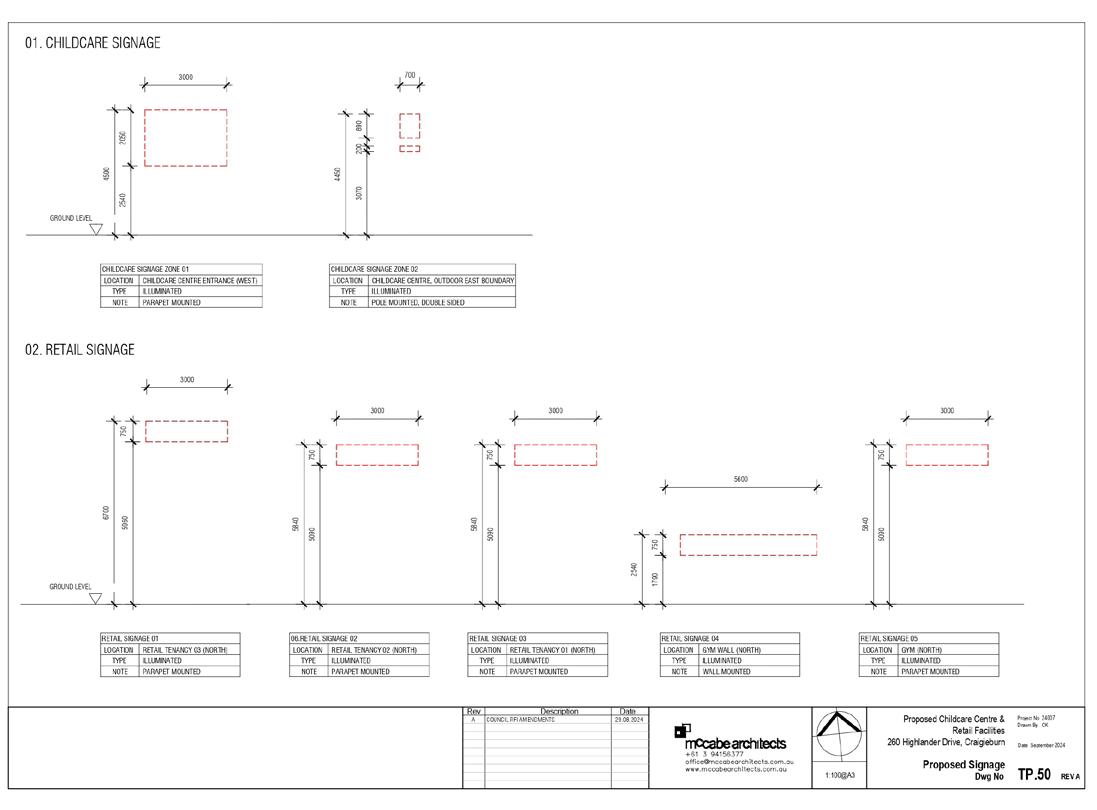
Concept Development
Mccabe Architects@2024

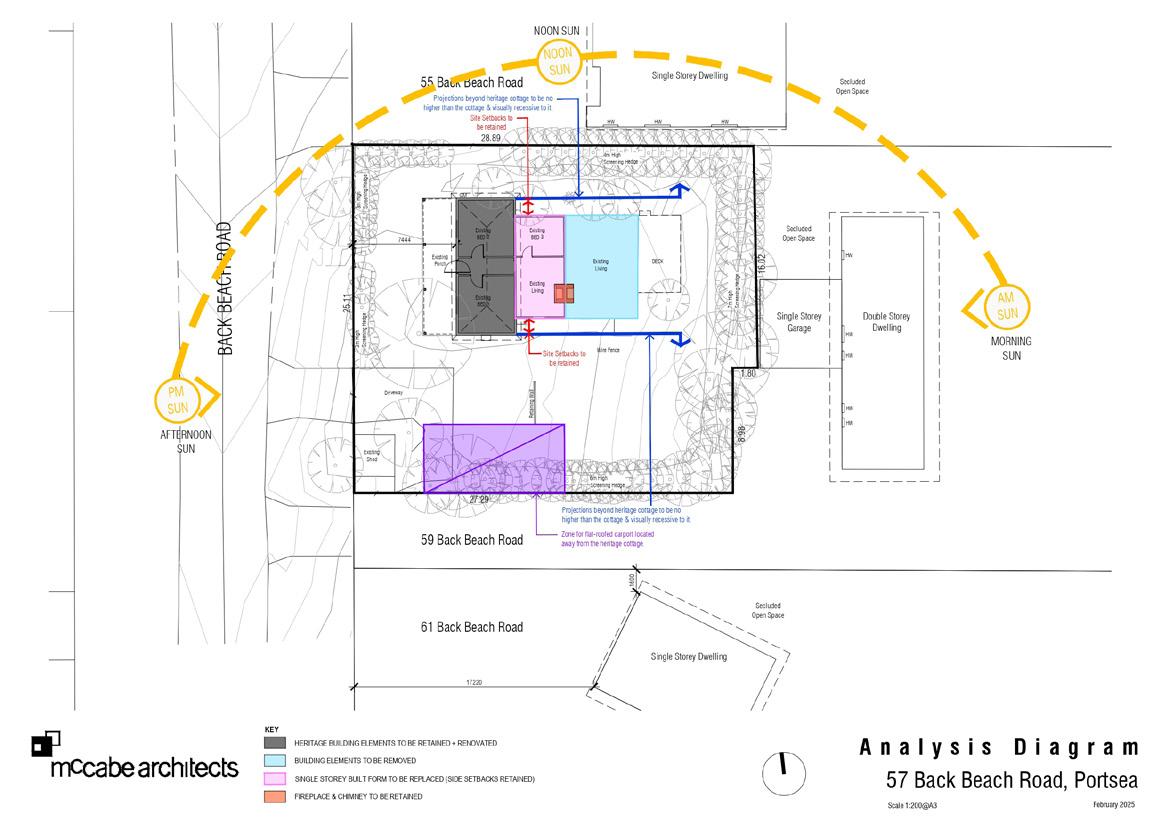
Analysis Site Section

Key Involvements
► Created graphic diagrams to communicate site restrictions and proposed solutions.
► Explored alternative extension options to optimise site potential.
► Developed 3D views to help the client visualise their future home.
► Produced clear, client-friendly drawings to support collaborative design feedback.
Projects Challenges
► Navigated heritage and excavation restrictions tied to the existing structure.
► Designed an extension that respected the original façade and street presence.
► Enhanced open space, natural light, and outdoor connectivity within a limited footprint.
Design Response


3D Modelling Presentation Preparation

Existing Streetviews

Orthographic Drawings
Proposed 3D Views



Waurn Ponds, VIC
Town Planning Application & 3D Visualisation Mccabe Architects@2024

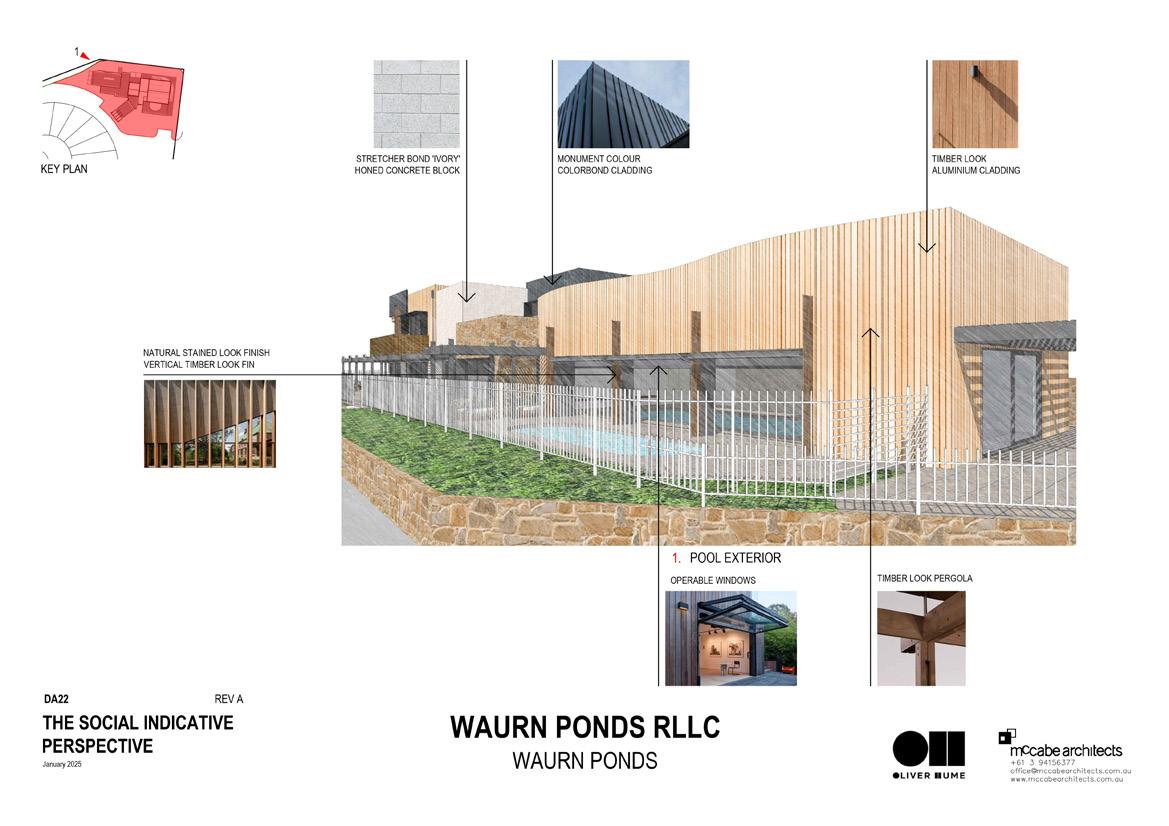
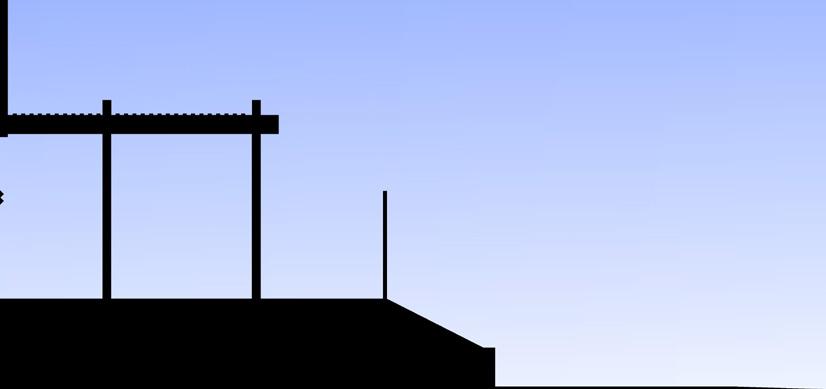
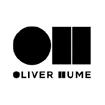
Key Involvements
► Developed 3D models to visualize design concepts.
► Prepared town planning drawings aligned with previously approved styles.
► Created interface details to illustrate interactions between pedestrians and space users.
► Compiled material sheets to help visualize the proposed design’s overall appearance.
Projects Challenges
► Aligned new client design with existing approved layout to avoid planning delays.
► Responded to limited site data by making informed design assumptions.
► Balanced site efficiency with spatial clarity between public and private zones.



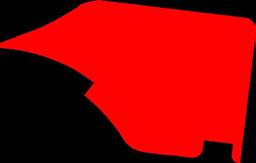

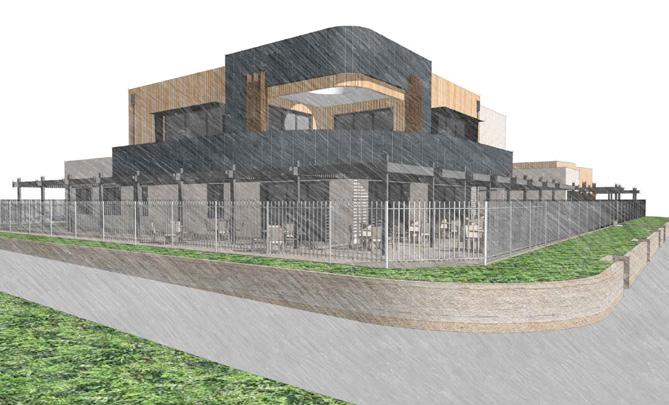






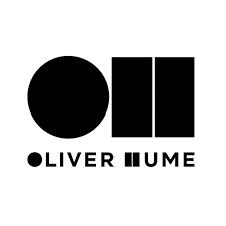

Town Planning Application & 3D Visualisation Mccabe Architects@2024
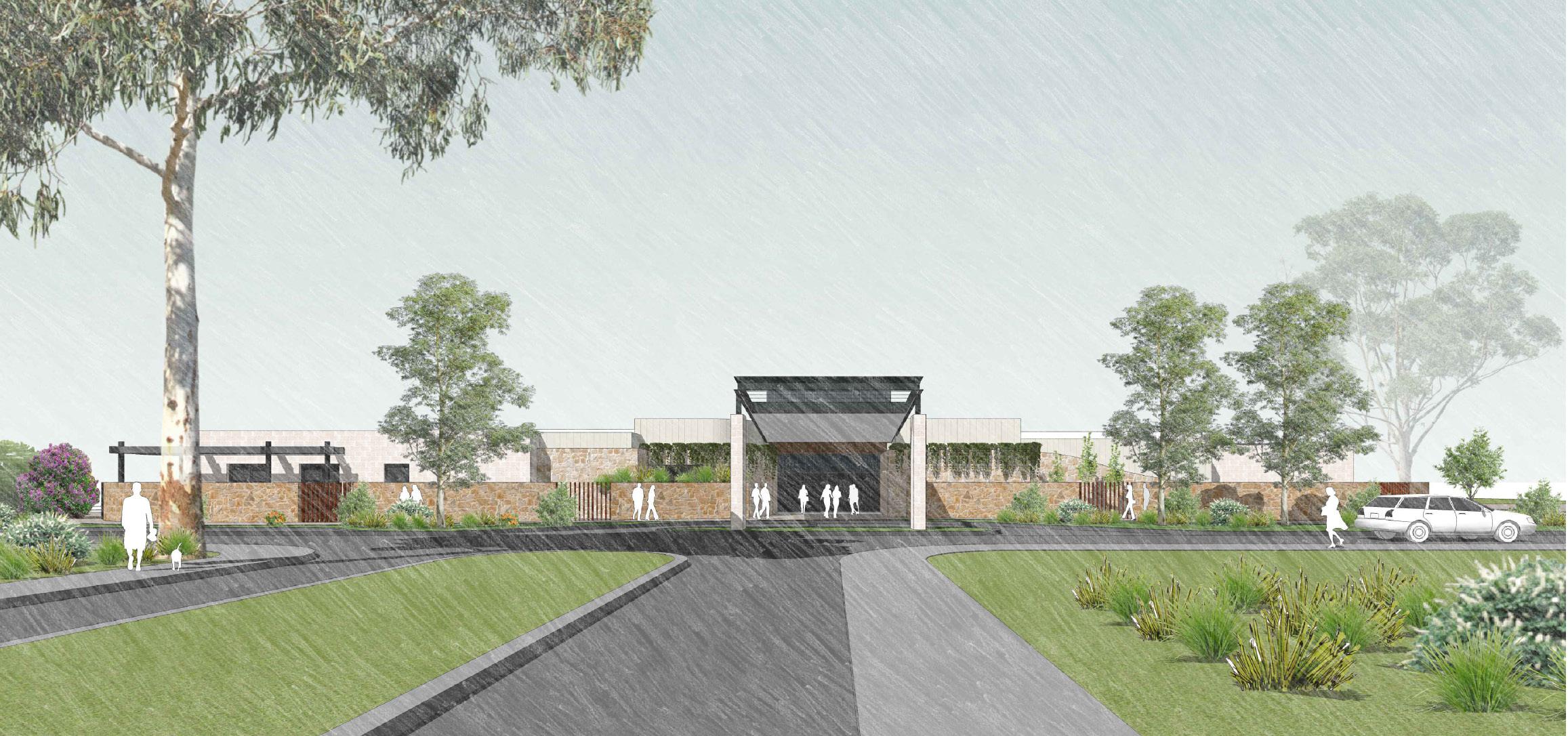
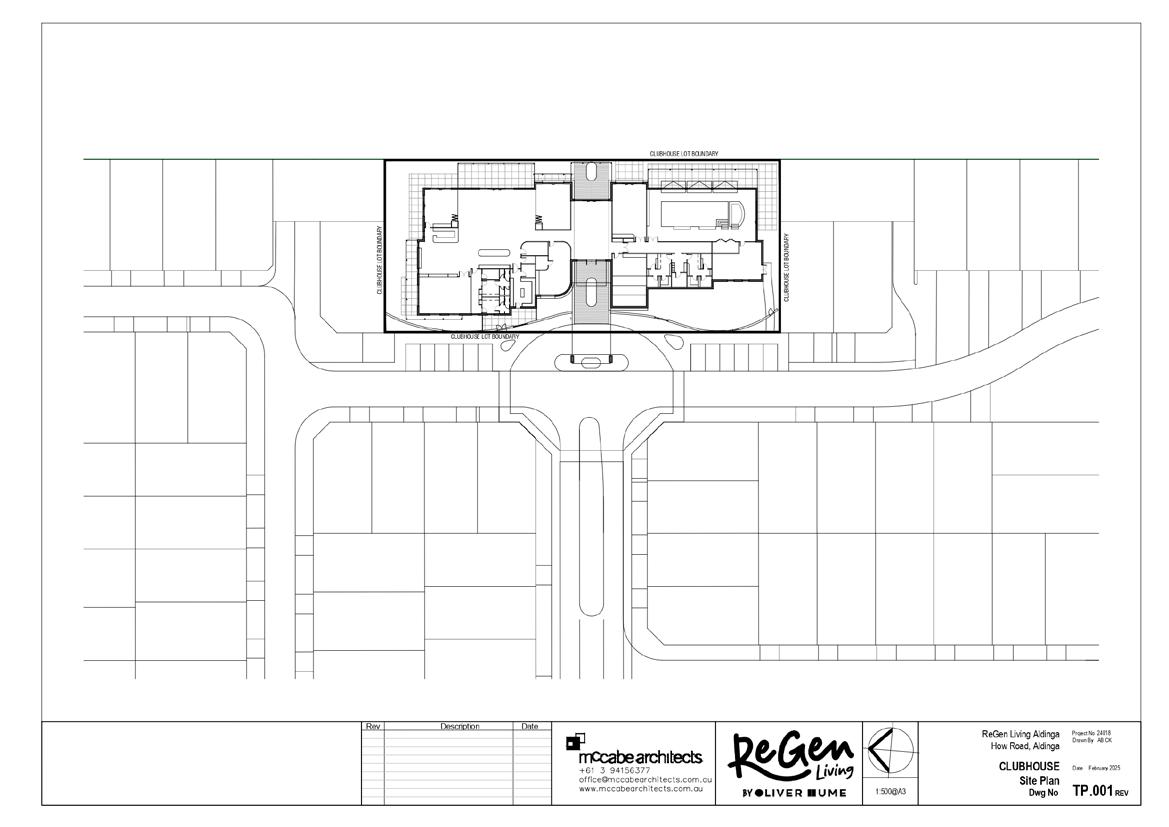
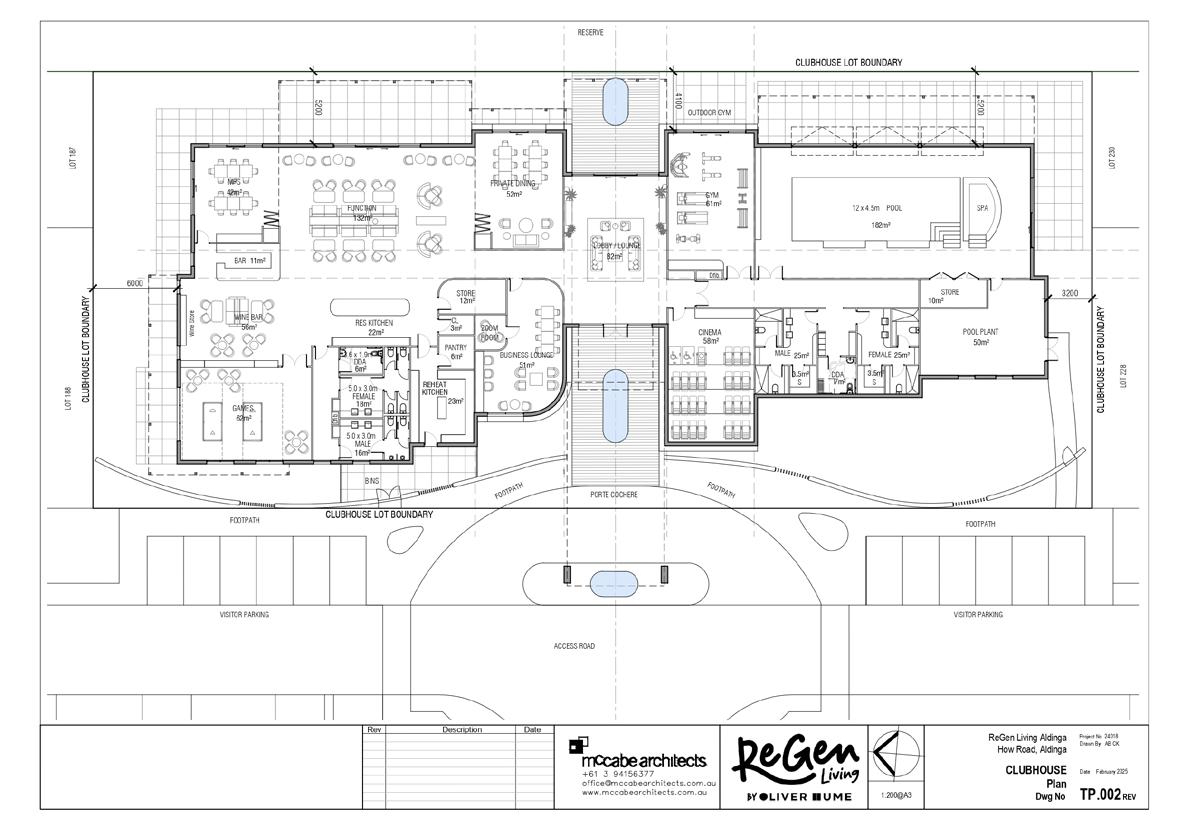
Key Involvements
► Developed 3D models to visualise design intent across multiple buildings.
► Prepared town planning drawings for the clubhouse, sports pavilion, and SEC building.
► Aligned design style & language with Waurn Ponds to create visual consistency.
► Adapted the clubhouse design language to suit a new context and scale.
Projects Challenges
► Translated Waurn Ponds’ design language into singlestorey community buildings.
► Applied consistent materials and forms across varied facility types.
► Completed full town planning submission within a tight 2.5week timeframe.


3D Modelling TP document Preparation

Clubhouse Elevations 01

Clubhouse Elevations 02

Sales Experience Centre Plans
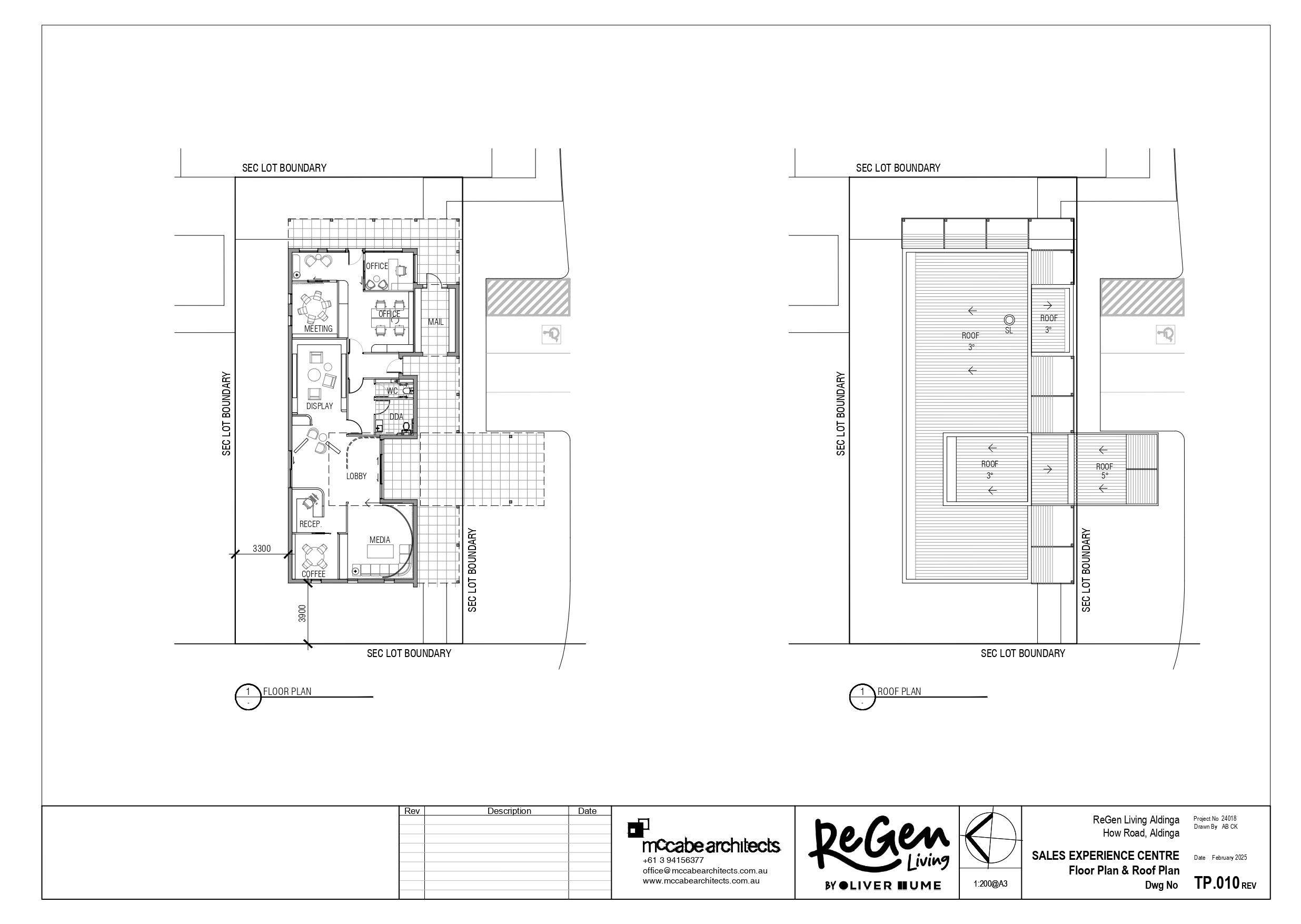
Sales Experience Centre Elevations

Hangout Building Plans

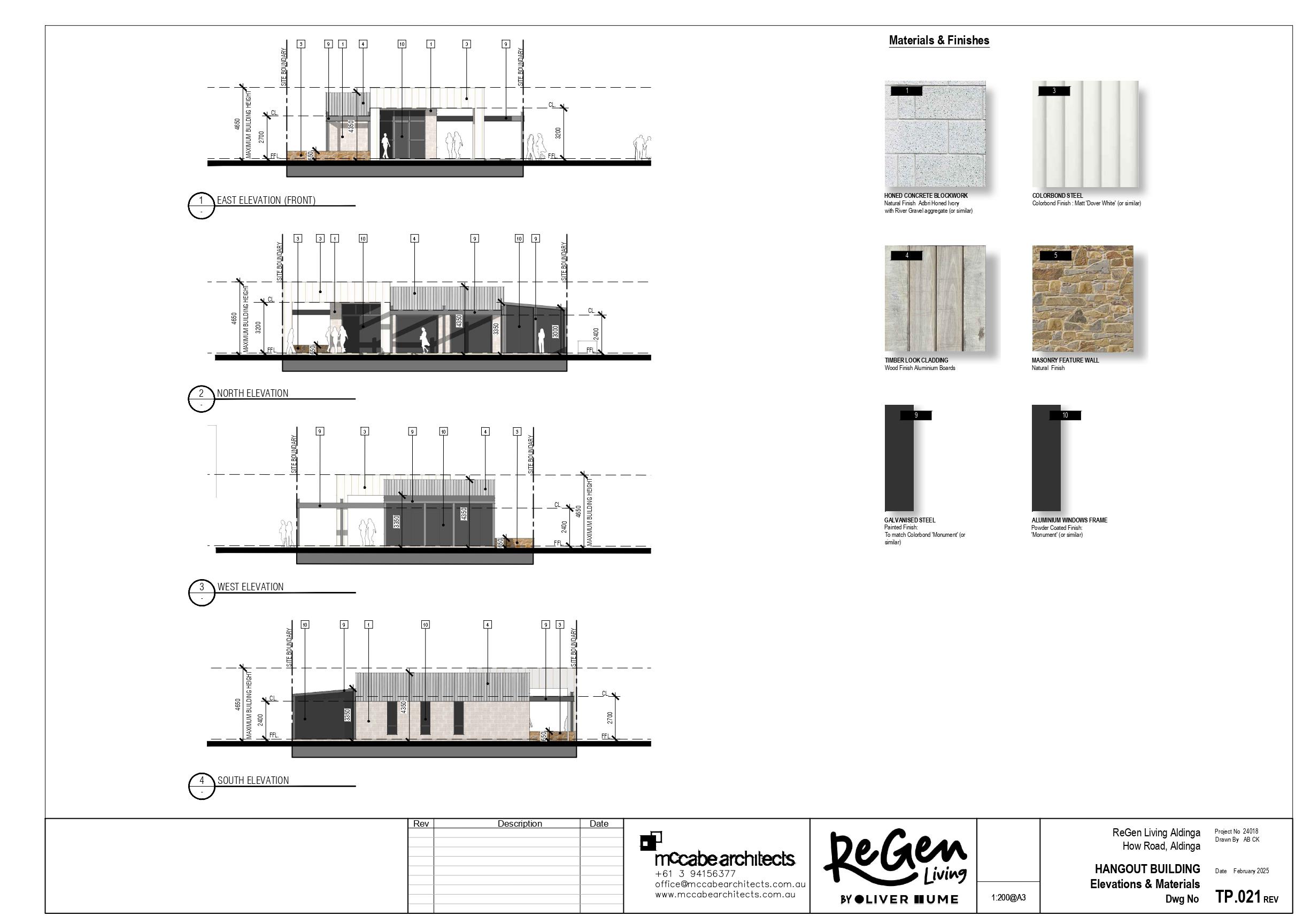
Town Planning Application & 3D Visualisation Mccabe Architects@2025
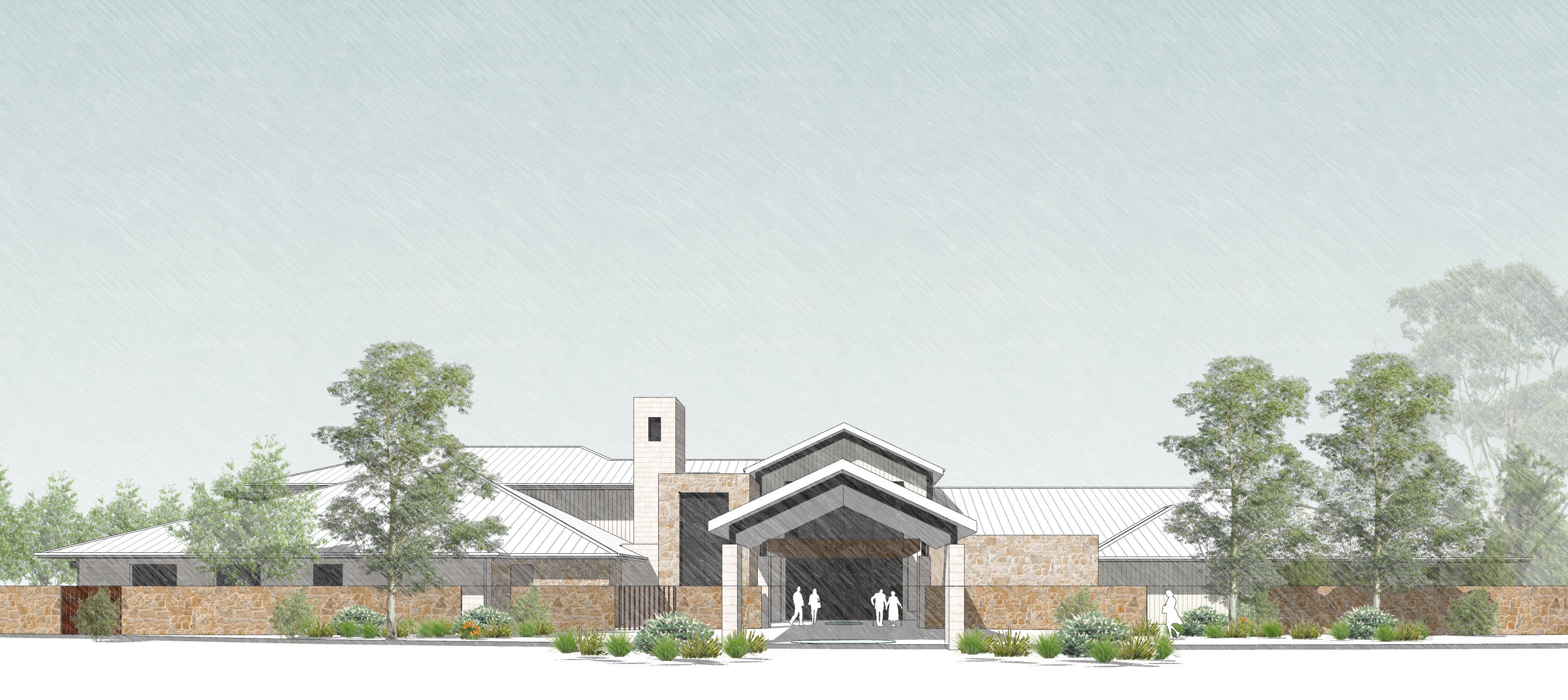
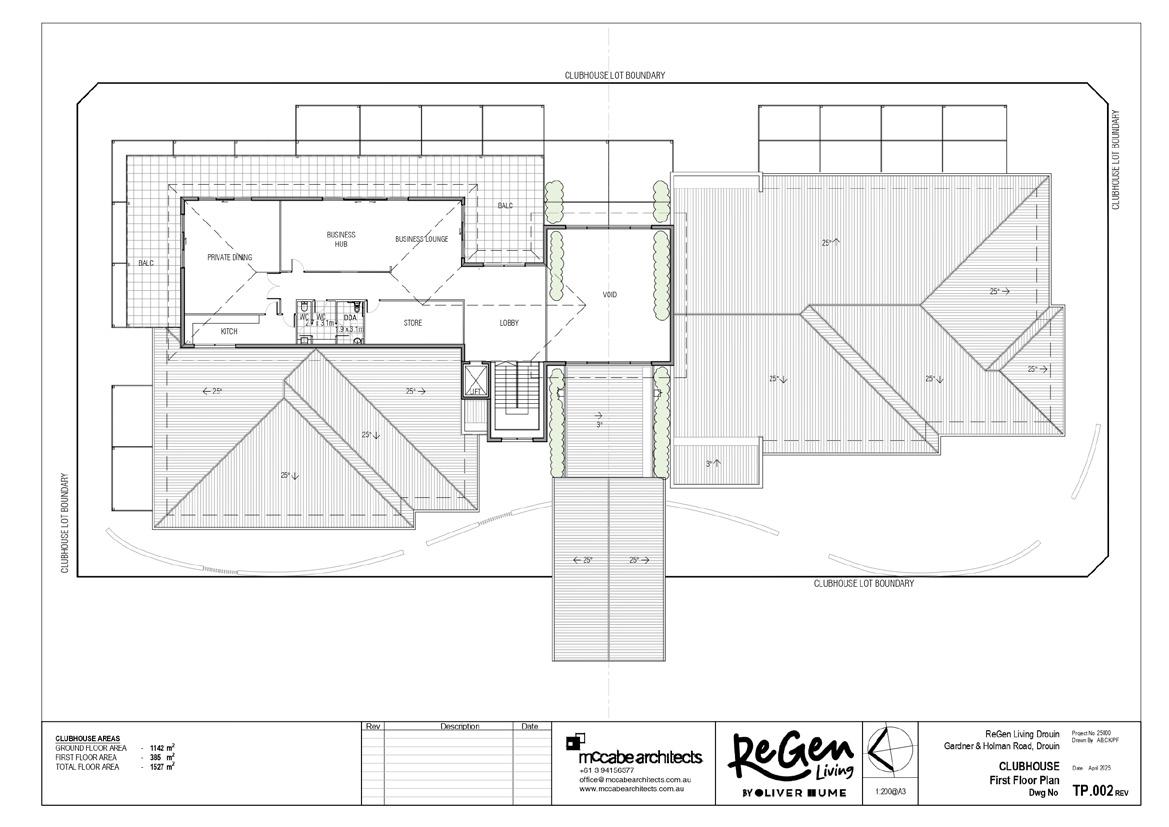
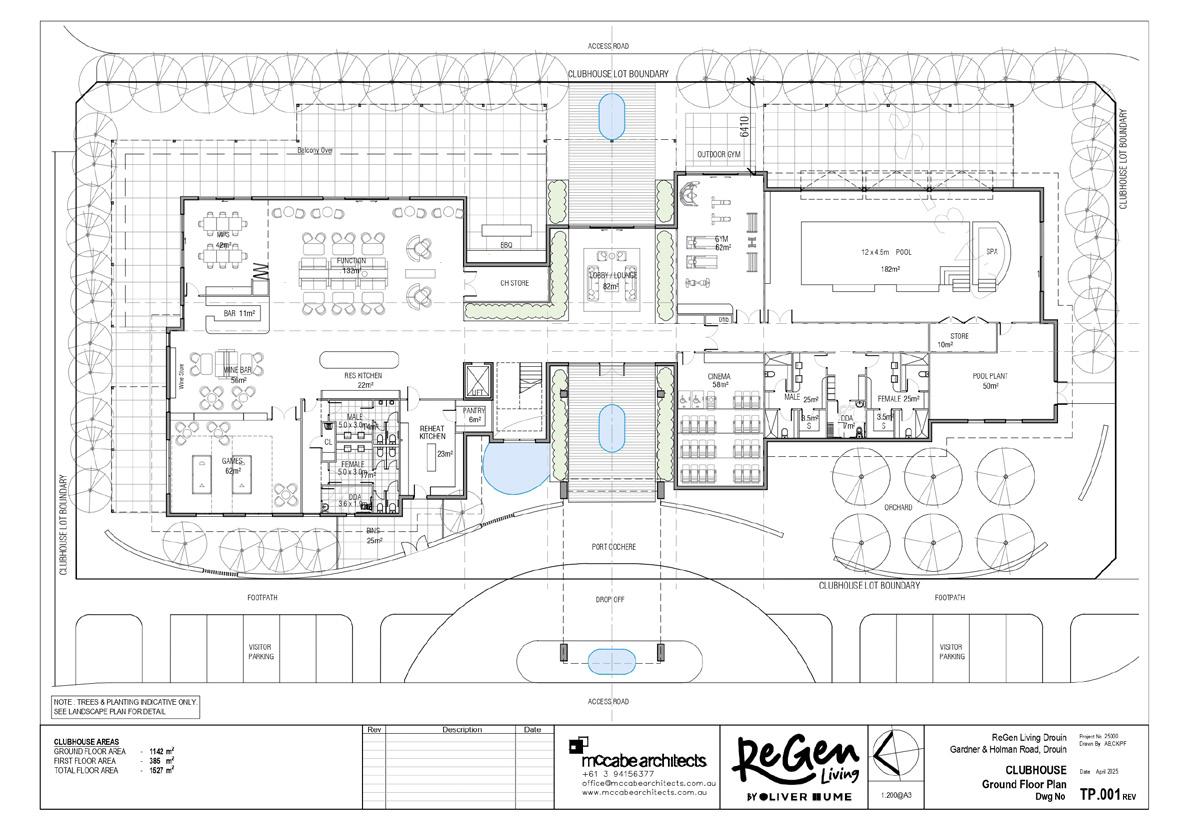
► Developed 3D models to visualise design intent across multiple buildings.
► Prepared town planning drawings for the clubhouse and all other communal facilities.
► Aligned design style & language with Waurn Ponds to create visual consistency.
► Adapted the clubhouse design language to suit a new context and scale.
► Modified the original design into a more classical style with pitched roofs.
► Ensured key spaces were oriented to maximise views across the site.
► Applied consistent materials and forms to various community facilities.
► Delivered a full town planning submission within a tight 2.5-week deadline.


3D Modelling TP document Preparation

Clubhouse Elevations 01
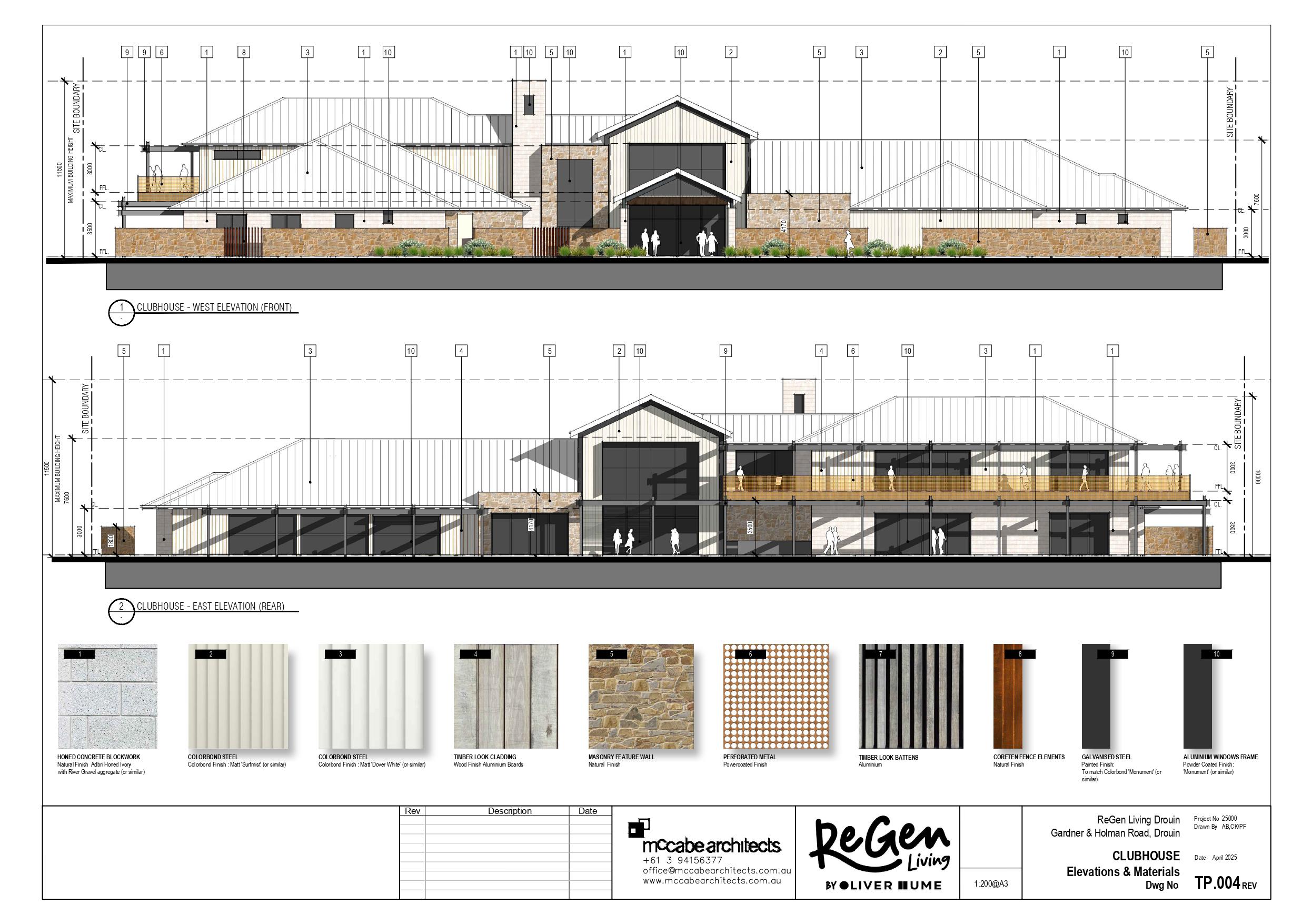
Elevations 02

Sales Experience Centre Plans & Elevations

Lakehouse Building Plans & Elevations

Hangout Building Plans & Elevations
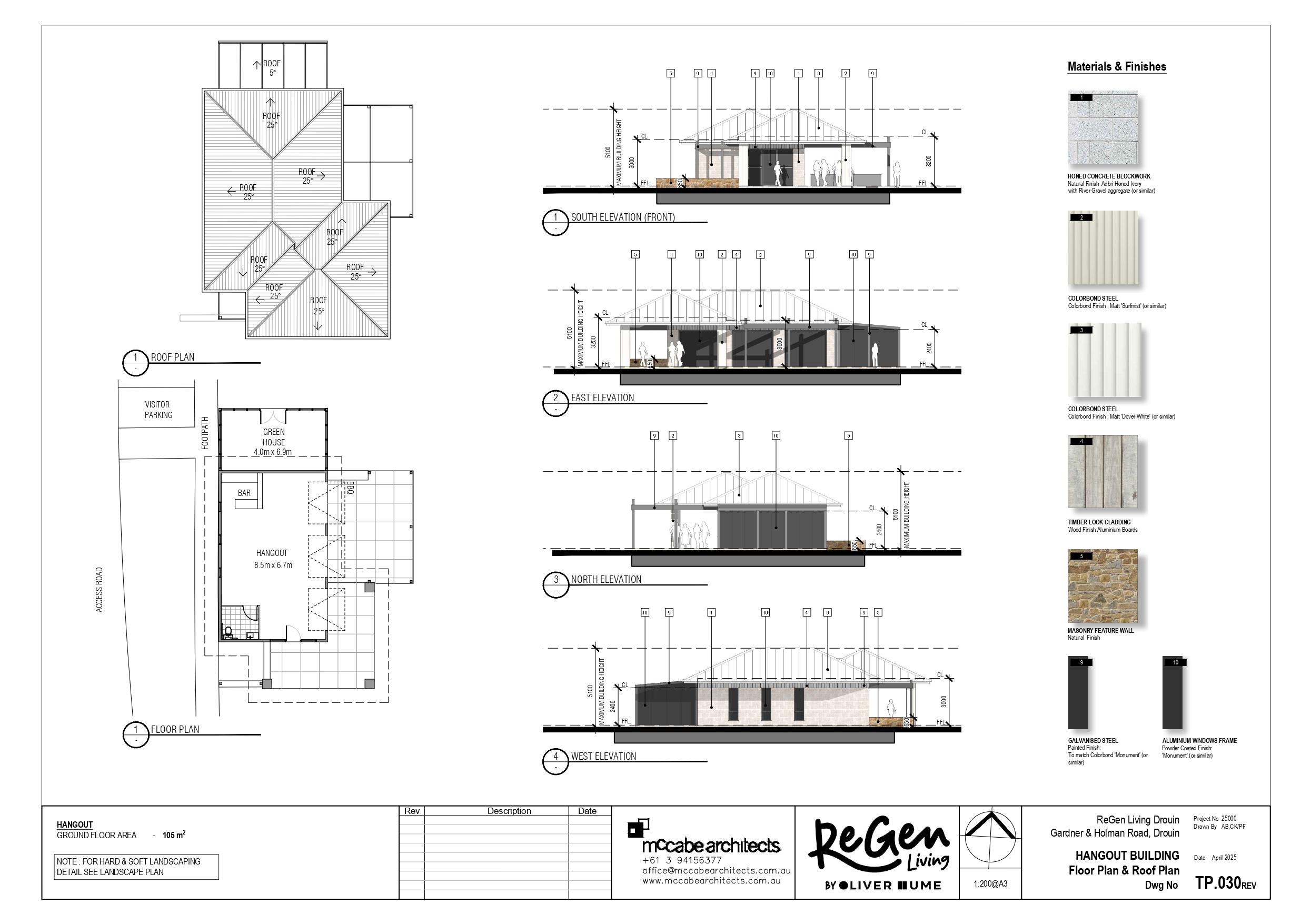
Sport Pavilion Plans & Elevations

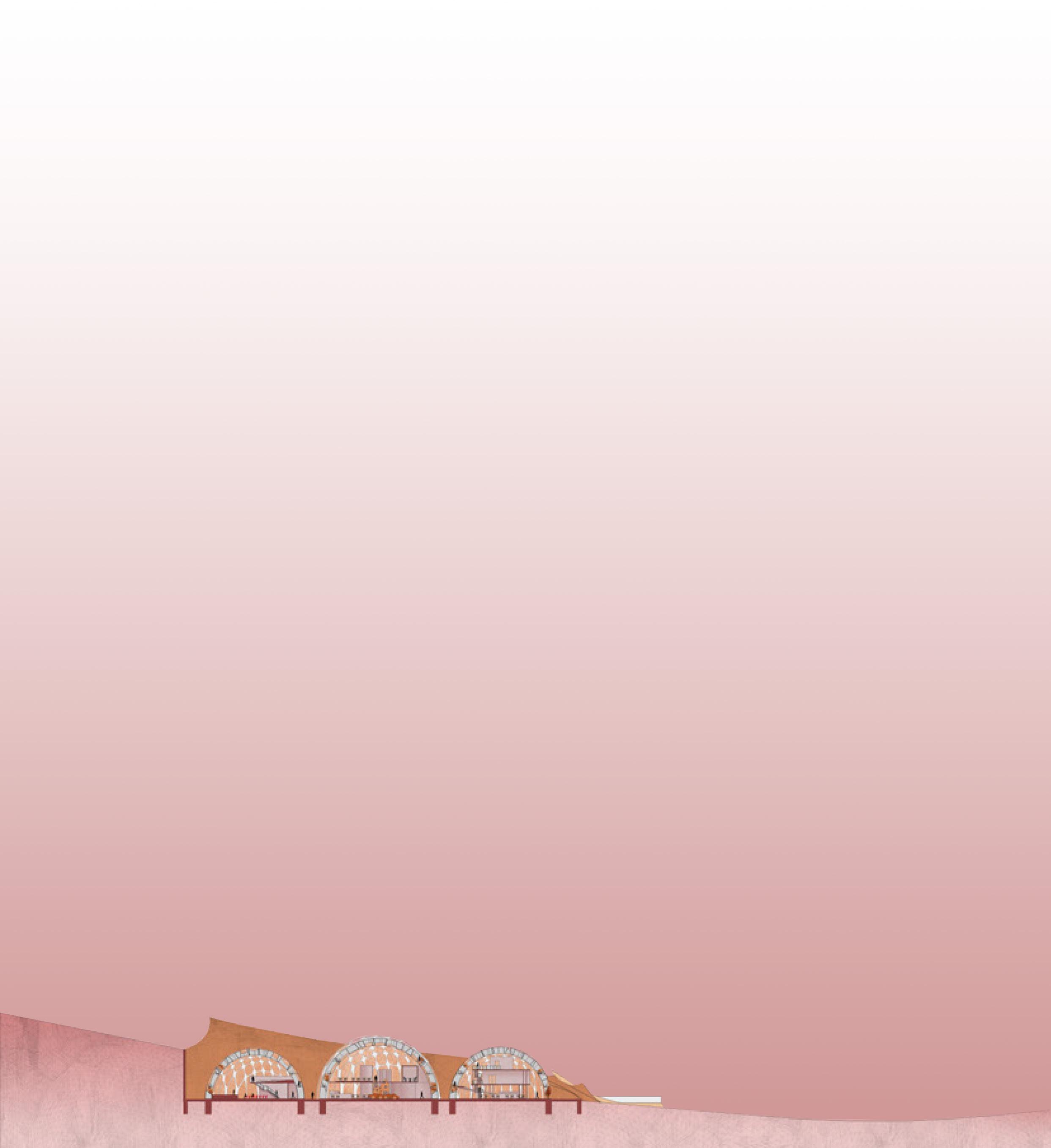
Final Year Design Studio
University of Adelaide@2021
Tutor : Ms.Mirai Morita
Email : mirai.mmorita@adelaide.edu.au
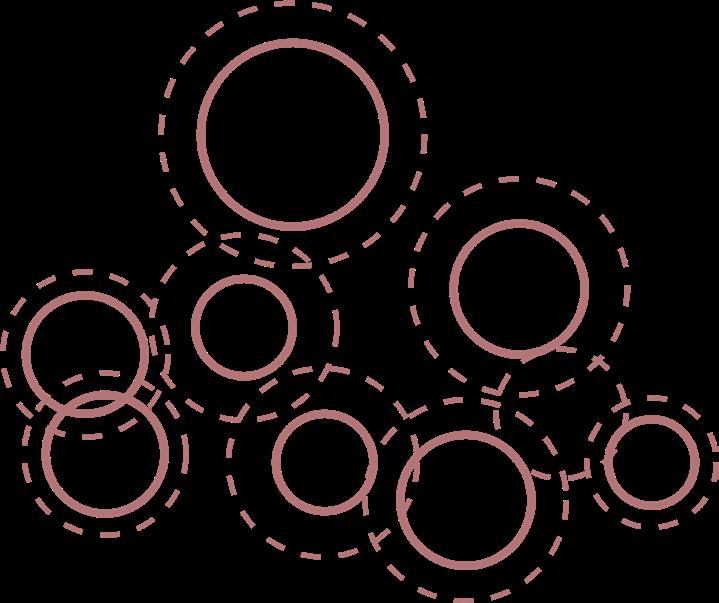
Final Year Design Studio
University of Adelaide@2021
What comes to mind when you think of insects? Some may be fascinated by them, while others might shy away. Insects play a crucial yet often overlooked role in our ecosystem. But as architects, what can we learn from the intriguing world of insects?
Tutor : Ms.Mirai Morita
Email: mirai.morita@adelaide.edu.au
Phone: 08 83134588
What do you think when you hear insect? Some may like them, some may not. Insects are an integral part of this planet, which is often overlooked. Let’s think about what we can do as architects with the fascinating world of insects.
For this project, we focused on ladybirds, exploring their unique characteristics through research and design. The result is Prey Deployer—a project centered on ladybird research, breeding, pest control, and even tourism, blending functionality and fascination.
In this project, ladybirds were chosen as the insect to study and design based on the study. Prey Deployer is a project about ladybird research, breeding, pest-killing and tourist visiting.

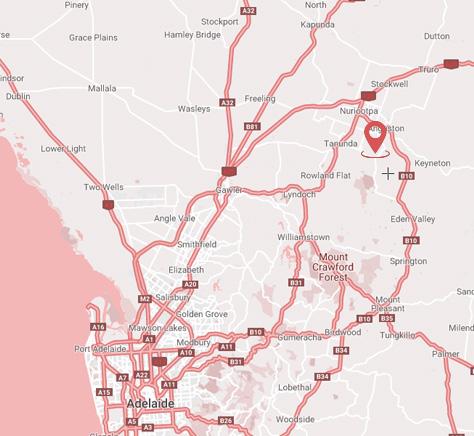
Elements Extraction from Ladybirds Plant Hospital
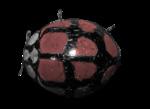
Deconstruct the pattern of the ladybird shell into circles
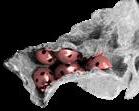

Ladybird hide under rock or wood Ladybird usually hide under wood or rock to prevent heat lost.
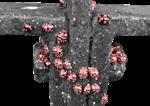
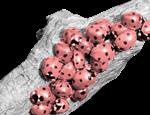










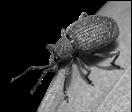


Ladybird Shell Pattern
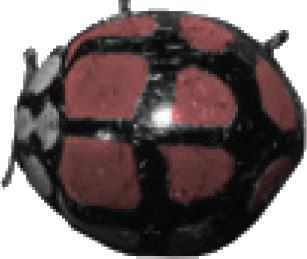

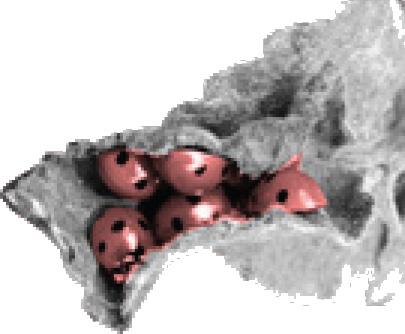
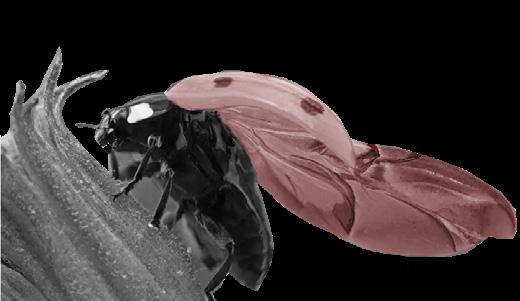
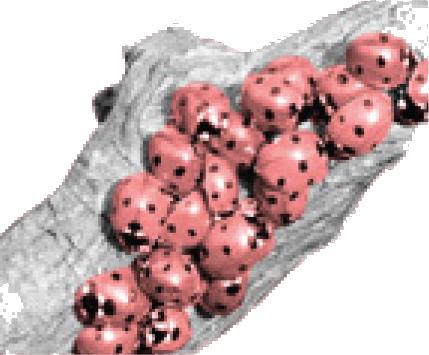
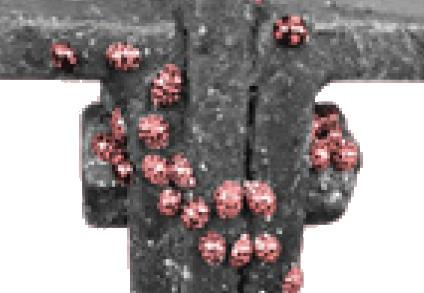
The ladybird’s black spots inspire circular openings on the dome façade, bringing in natural light and adding visual interest Larger openings at the base and smaller ones at the top create dynamic depth, enhancing the play of light and shadow.
Symmetrical Patterning with Parametric Design
The symmetrical spot pattern of the ladybird informs a parametric design approach. Mirroring the spots along the dome’s axis creates a balanced, organic pattern, adapting the design to the dome’s geometry.
Low-Profile Structures Inspired by Ladybird Habits
Ladybirds hiding under rocks inspire low-profile, partially buried structures that blend with the topography. This design offers insulation, protection, and harmony with the natural landscape.
Double Façade Design
The ladybird’s shell inspires a double façade, where the outer layer protects against elements, and the inner layer ensures comfort while reflecting natural aesthetics.
Clustered Form Design Inspired by Hibernation
Ladybirds’ clustered hibernation inspires compact, interconnected building forms, enhancing thermal efficiency and creating intimate, sheltered spaces that foster community.
Form Orientation and Solar Exposure
Inspired by ladybirds’ orientation toward sunlight, the building’s form is aligned to maximize solar exposure, enhancing warmth and energy efficiency.
Topography
Barossa Valley’s varied elevations offer opportunities to integrate buildings with the landscape. The height differences allow for playful use of terraces, hidden spaces, and vantage points, creating both visual interest and practical designs that harmonize with the terrain.
Circulation Appearance
The site’s elevation changes make surface-level movement challenging An underground circulation system connects the scattered domes, providing seamless transitions between areas and simplifying navigation while integrating with the natural terrain.
The dome design offers opportunities for organic, flowing forms inspired by the ladybird’s shell. Partially hidden structures blend with the landscape, creating sheltered spaces. Scattered domes provide flexible layouts and dynamic light, while intersecting domes maximize spatial efficiency and visual impact
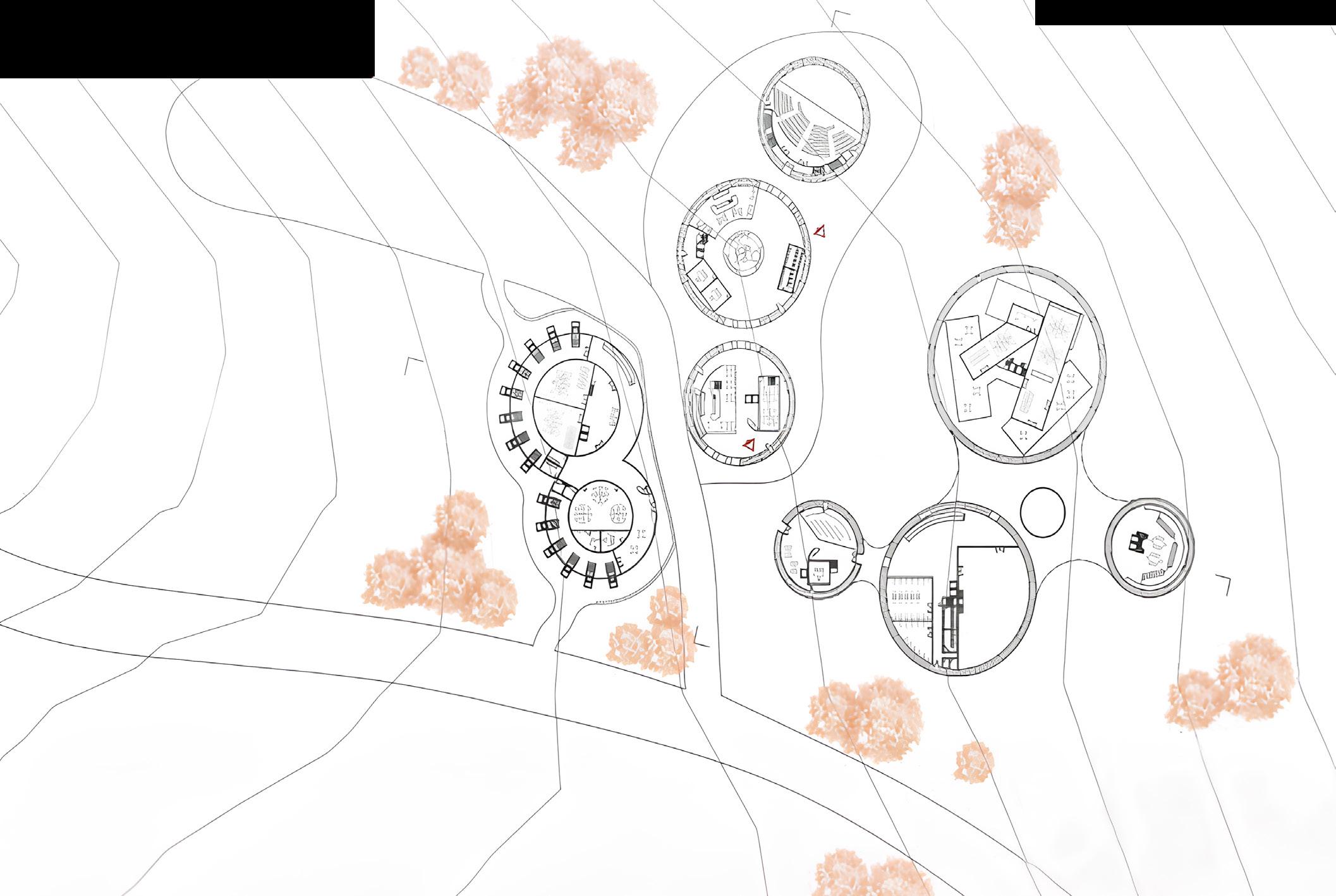



Insectarium for Spiders and Territorial Insects Insectarium for Ladybirds Insectarium for Lacewings
Design: Longer, thinner, with low sunlight exposure
Features: Tree shrubs provide space for spiders, reducing cannibalism. Limited sunlight maintains a controlled environment, with nectar and pollen secondary to biocontrol experiments.
Design: Wider, shorter, with moderate sunlight exposure
Features: Flowers and shrubs cultivate pests as food. Sunlight aids nectar and pollen growth, supporting ladybird energy and egg-laying, with a spacious layout for plant variety.
Design: Square with circular edges, highest sunlight exposure
Features: Sunlight boosts nectar and pollen production. The design maximizes light capture and plant growth, creating an optimal environment for lacewings’ energy needs and reproduction.
Plant Hospital Section Inspired by Function
The two intersecting domes symbolize the ladybird’s role in pest control, emphasizing their functional benefits in biological pest management. The open design supports commercial operations, providing ample space for offices, storage, and specialized transportation for distributing ladybirds to farms.
Tourist Section Inspired by Habits
The dome is partially hidden by an overhang, mimicking the way ladybirds hide under rocks or leaves. This creates a semioutdoor space beneath, offering shelter and a natural feel. The design uses light strategically, where the cafeteria inside the dome gets ample sunlight, while the overhang provides a cozy atmosphere that reflects the protective nature of ladybird habitats.
Research Section Inspired by Appearance
This section features a doublelayer façade with insectariums between the layers, drawing inspiration from the ladybird’s protective shell. The domes are scattered above ground but interconnected below, much like how ladybirds cluster during hibernation. The underground circulation mirrors the hidden connections in nature, linking the scattered forms.

01. Plant Hospital Section Reception, Service Centre, Office, Storage, Cold Room.
02. Tourist Section Reception, Theatre, Cafeteria, Gallery, Landscaped Park
03. Research Section Office, Laboratory, Insectarium Loop Trail, Cafeteria, Library.

Port Adelaide
Studio Cultures
University of Adelaide@2020
Tutor : Athanasios Lazarou
Email : athanasios.lazarou@adelaide.edu.au


Past
Port Adelaide flourished between the 1820s and 1920s, leveraging its prime location for maritime trade and becoming a bustling hub of activity.
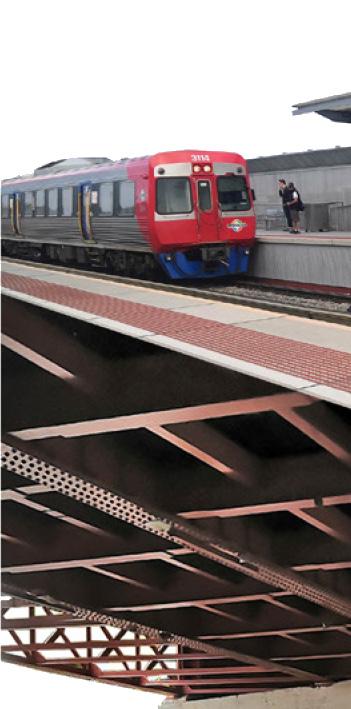
What do you picture when you think of a train station? Is it merely a stop on the journey, or could it be more?
The Sport Station project explores this question through the redevelopment of Port Adelaide’s elevated railway station, a key stop on the Outer Harbor Line. Once a prominent architectural feature of the Adelaide Metropolitan network, the station has since been reduced to its most minimal form, both in design and function.
The goal of Sport Station is to breathe new life into this space, transforming it from a neglected transit point into a dynamic part of the urban landscape—a place to be, not just pass through but play a much stronger part in the urban framework so that it can be considered a place rather than a non-space or unloved passingthrough point.
Today, much of that vibrancy has diminished, with only the station’s viaduct, arches, and columns remaining as silent witnesses to its former architectural glory.
The Sport Station envisions a transformation, turning the railway station into a vibrant urban space that reconnects Port Adelaide with its community.

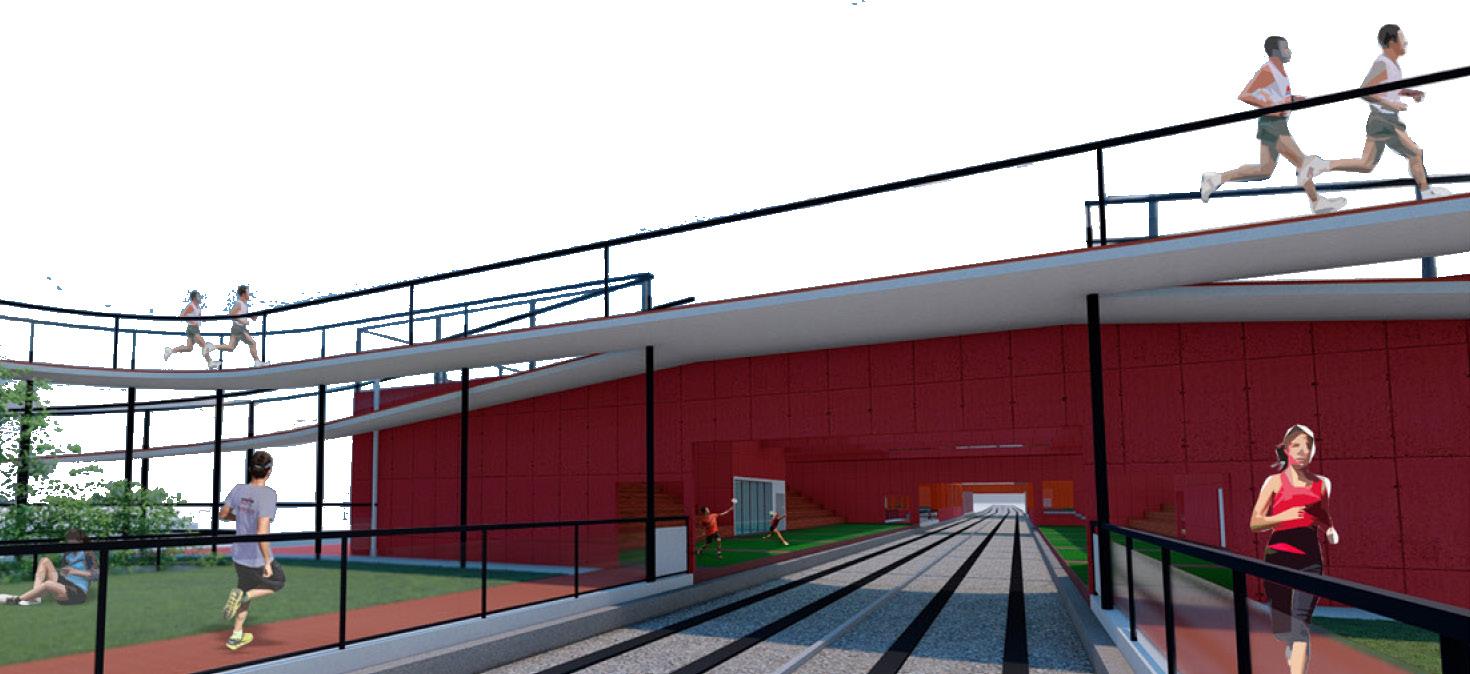
The Port Adelaide railway station, once a vibrant part of a bustling maritime hub, has become a neglected and underutilized transit point. Its current state as a silent relic of the past— characterized by decaying viaducts, arches, and columns fails to engage the community and has lost its relevance within the urban framework. The challenge lies in reconnecting this space with the community and restoring its vitality.
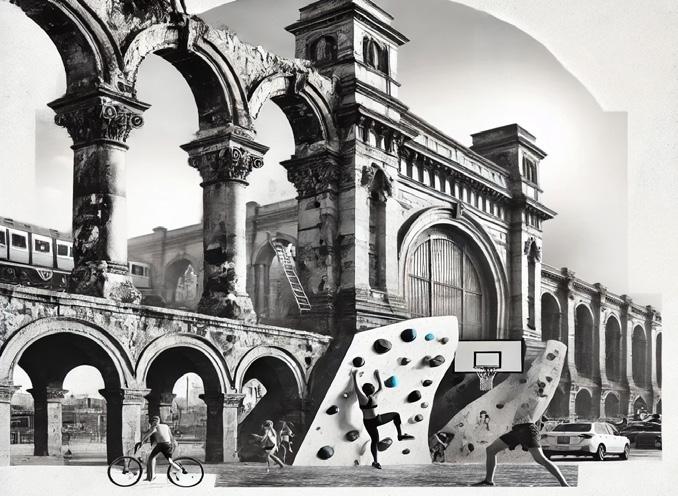
The station’s viaducts, arches, and columns inspired the design’s use of posts and columns to create larger open spaces with minimal walls, enhancing visual connectivity. The repetitive nature of these elements guided the geometric and modular design, preserving the station’s historic character while ensuring a cohesive, modern layout.
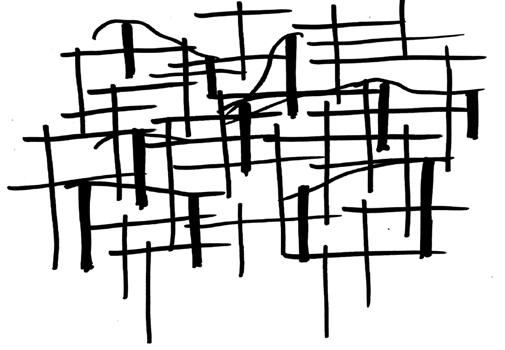

The decline of Port Adelaide’s community and vibrancy is tied to the reduced reliance on its port, leading to economic downturns and underutilized spaces. As maritime trade diminished, the local culture and shared community spaces faded. The station, once central to daily life, fell into disrepair, and the modern urban focus on cars over pedestrians further disconnected the community, eroding local traditions and interactions. These shifts symbolize the disconnection from the past and the loss of Port Adelaide’s vibrant identity
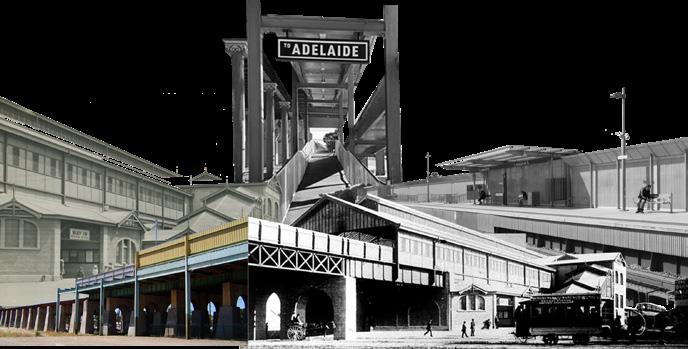
The study of the pavement pattern revealed repetitive forms that affected walkability and community connection. This inspired the modular design for Sport Station, with the cubes and cuboids reflecting these patterns. By addressing walkability and enhancing spatial cohesion, the design fosters connectivity, movement, and community engagement, transforming the station into a dynamic, interactive space.
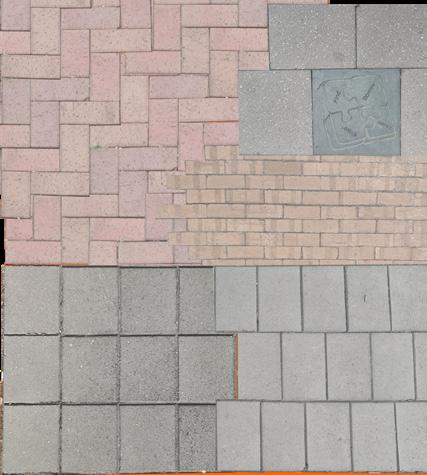

Sport as Catalyst
Building on Port Adelaide’s rich sporting heritage, this project seeks to create a community-centered sports hub aimed at addressing disengagement. By integrating trending sports that complement existing nearby facilities, the design encourages participation and promotes physical activity. Sports are used as a powerful tool to reconnect the community, fostering social bonds and revitalizing the station through shared experiences.







The Sport Station’s design is based on and arranging four modular units experience, circulation, and walkability. The modular units are stacked to create a cohesive form that responds to spatial needs, ensuring smooth transitions between different sports facilities and public spaces.
The modular approach is inspired by the station’s remaining architectural elements—viaducts, arches, and columns. The repetition of these elements led to a geometric design that minimizes obstructive walls and maximizes visual connectivity between levels. The modular units’ design reflects this repetition, creating a cohesive and dynamic space that maintains a visual and functional connection to the station’s historical grandeur.
Type A (5m x 5m):
Designed for small, flexible spaces such as cafeterias and snack shops. This unit accommodates compact activities, reflecting the need for functional yet intimate environments.
Type B (5m x 9m):
Utilized for general spaces like toilets and fitness areas, this module caters to functions requiring more room without specific size constraints. It is the most frequently used unit on-site, ensuring versatility and adaptability.
Type C (18m x 9m):
This module is sized to fit a standard badminton court. It can be combined with additional units to form larger spaces, such as basketball courts, enhancing flexibility in sports facilities.
Type D (18m x 27m):
The largest module, used for expansive activities like swimming pools and bouldering gyms. Its size supports large-scale activities and provides the necessary space for high-intensity sports.


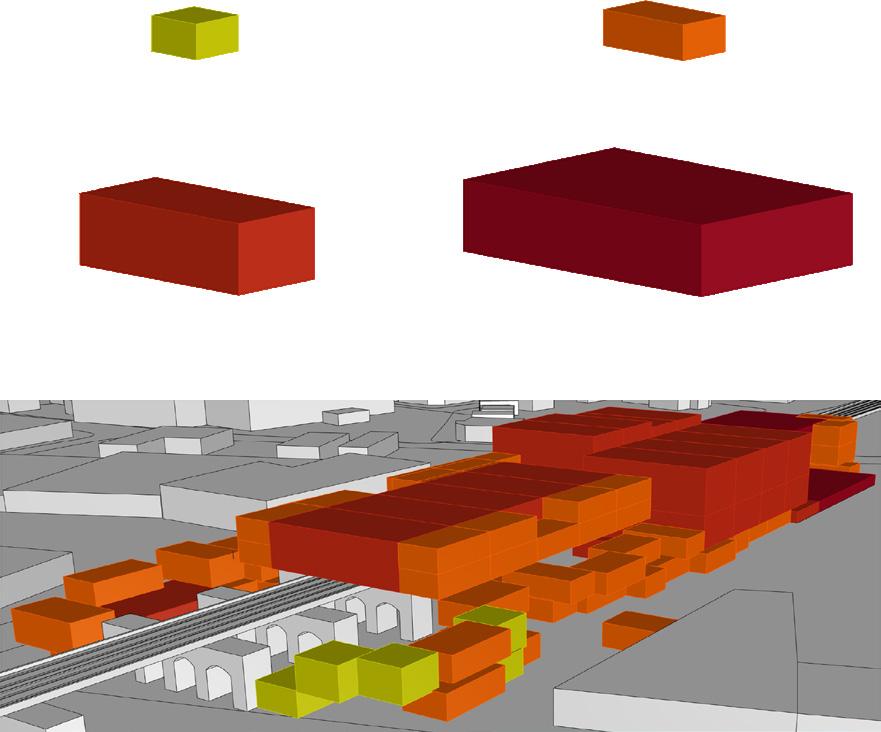

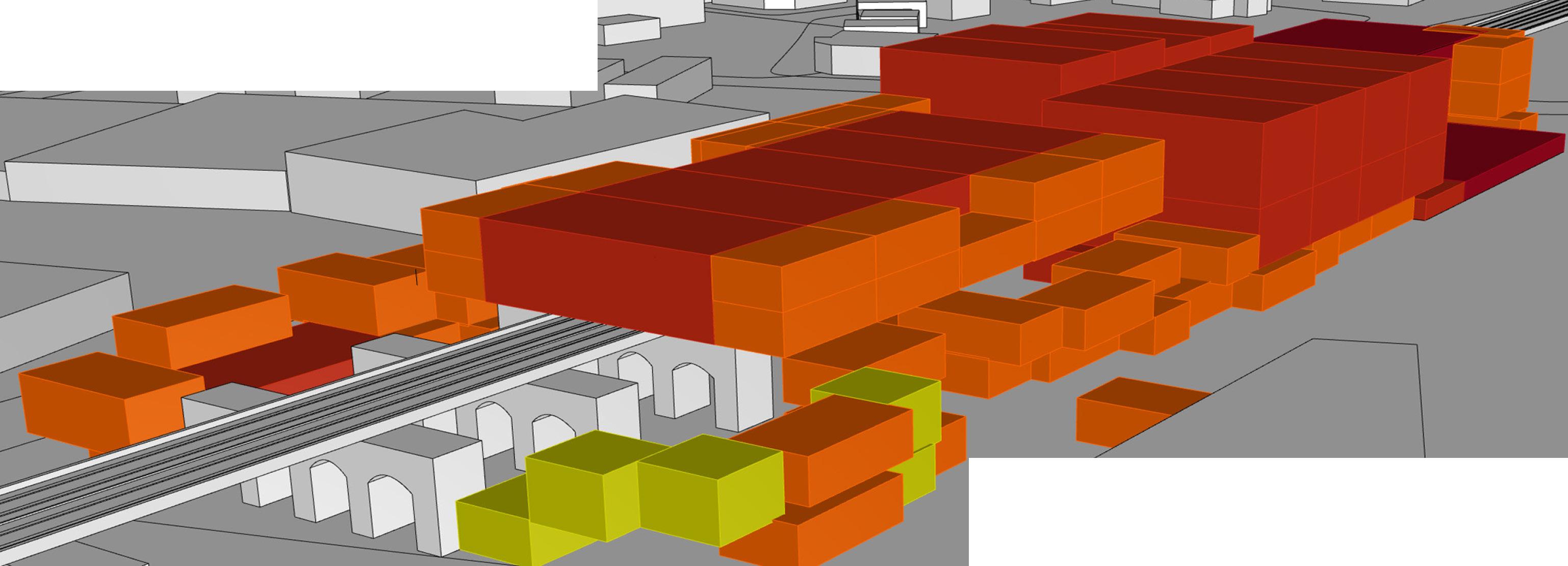

The design aims to create a sports community center that incorporates trending sports to attract people and encourage physical activity. Through sports, social connections and community engagement are strengthened. Unlike typical sports centers or train stations, this design integrates both functions, creating unique experiences along the track and path. Athletes can play sports alongside the railway, offering an exciting environment, while passengers witness activities like jogging and bouldering as they pass. This interaction creates a dynamic, engaging atmosphere that sets the project apart from other stations.


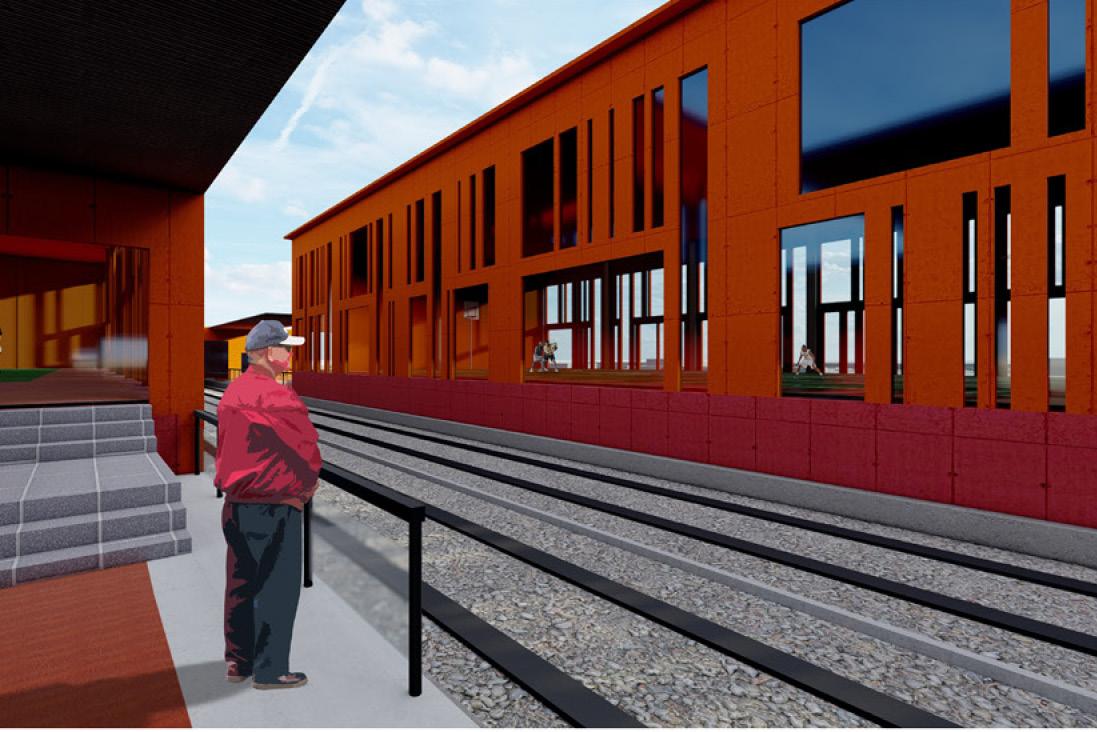
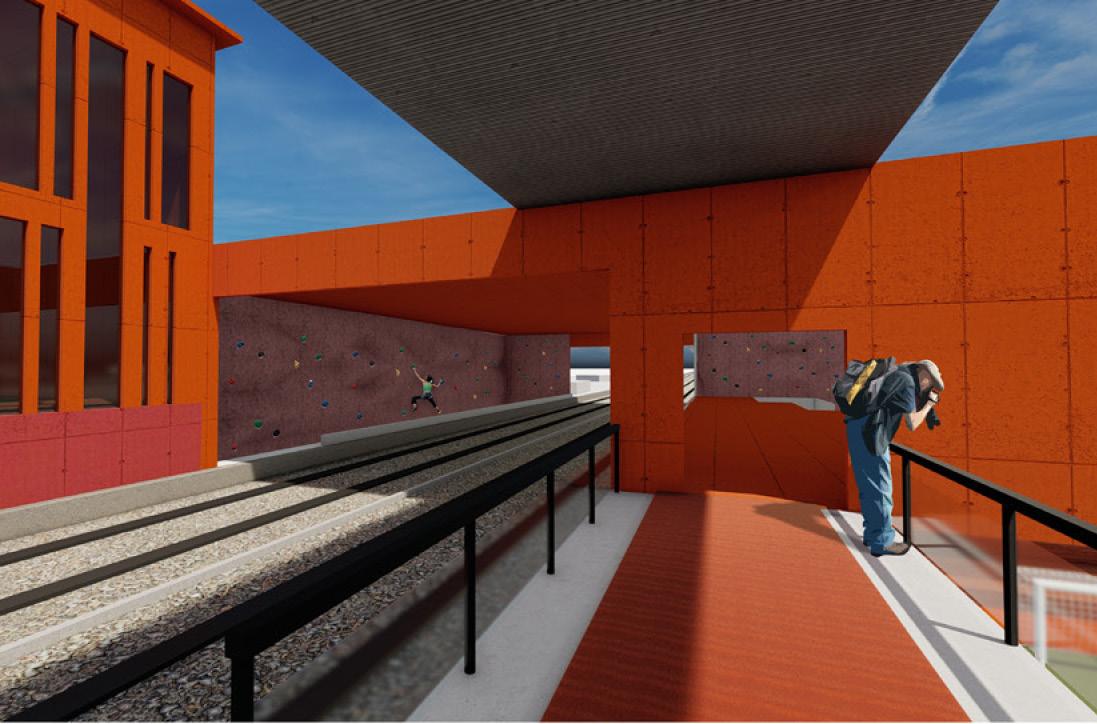
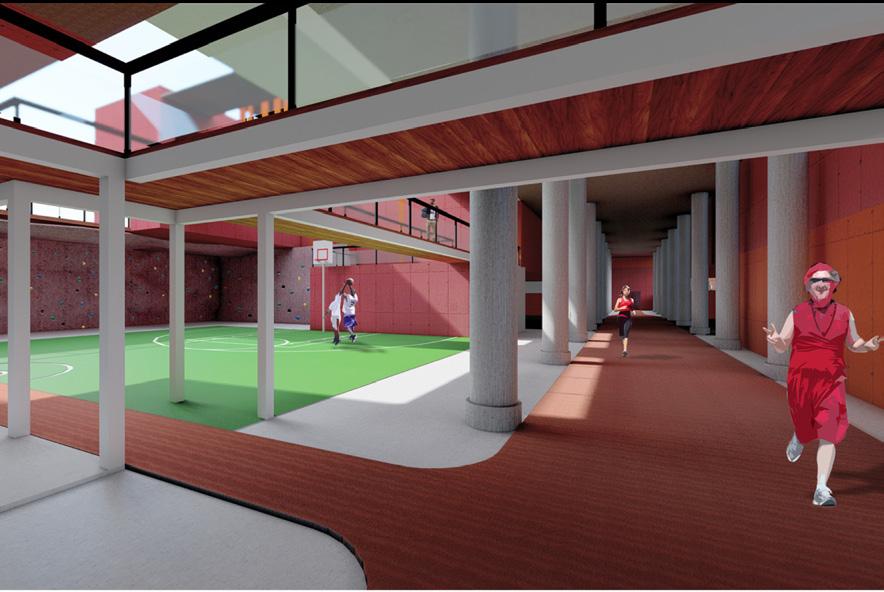
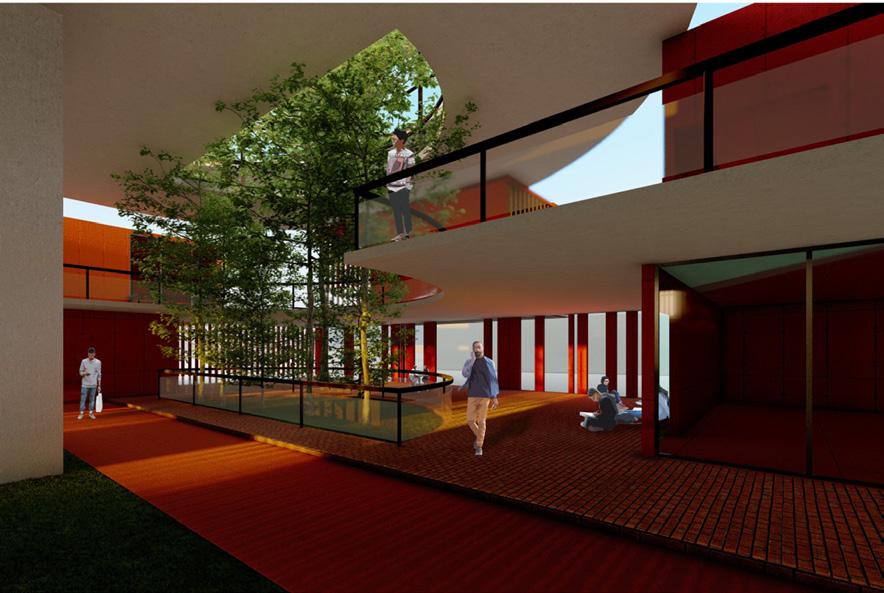
1. View from the waiting platform toward the elevated basketball court.
2. Perspective from the waiting platform to the distinctive bouldering wall.
3. Jogging track seamlessly connecting all areas of the station.


4. View highlighting preserved architectural elements as remnants of the past.
5. Shaded resting and picnic zone integrated with landscape design.
6. Shared sports spaces designed to enhance user interaction and engagement. 1 1 1 1 3 5 2

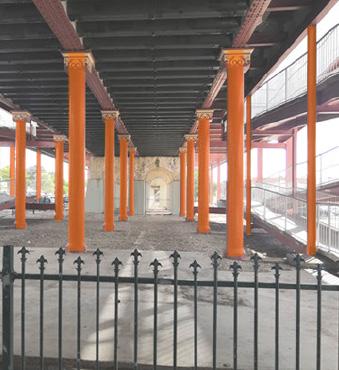
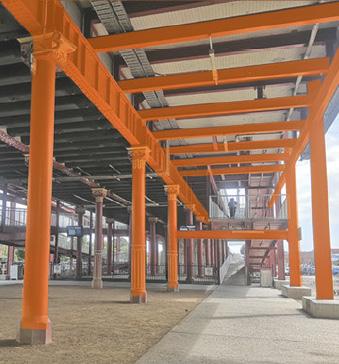

Roof Plan
The highest-level track features a lifting platform, offering a unique experience beyond typical treadmills or gardens. Runners enjoy views of Port Adelaide, with planted turf providing space for rest or yoga, attracting people to the station even when not traveling by train, thus boosting community interaction.
Platform Level Floor Plan
This level serves as the main waiting area for train passengers. The running track passes through different courts, exposing joggers to a variety of sports, encouraging them to try new activities and strengthening community bonds.
Ground Floor Plan
The track has multiple starting points, including from the Port Adelaide Plaza and beneath the bridge arch, offering an interesting running/jogging view. Different paths guide users to various spaces and serve as a warm-up before sports activities. While jogging, visual connectivity between joggers and sports players enhances interaction and fosters community connection.

